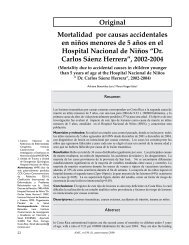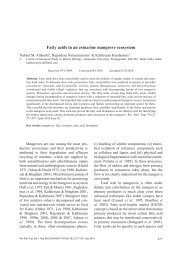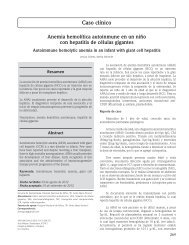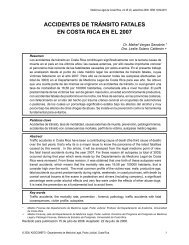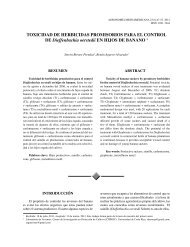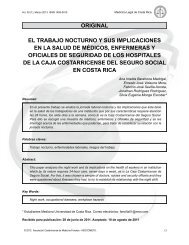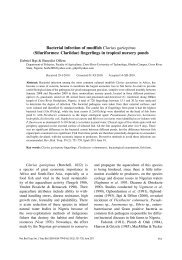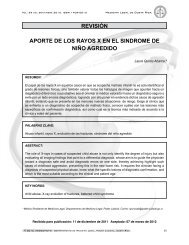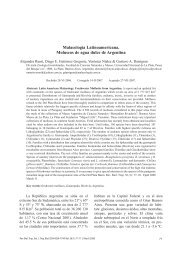Cucurbita moschata - SciELO
Cucurbita moschata - SciELO
Cucurbita moschata - SciELO
You also want an ePaper? Increase the reach of your titles
YUMPU automatically turns print PDFs into web optimized ePapers that Google loves.
In vitro plant regeneration system for tropical butternut squash genotypes<br />
(<strong>Cucurbita</strong> <strong>moschata</strong>)<br />
Marta Valdez-Melara 1 , Alexander García 1 , Marlon Delgado 1 , Andrés M. Gatica-Arias 1 & Pilar<br />
Ramírez-Fonseca 1,2<br />
1. Escuela de Biología, Universidad de Costa Rica, 11501-2060, San Pedro, Costa Rica. Tel: (506) 2075091, Fax: (506)<br />
2074216; marta.valdez@ucr.ac.cr; andresgat@gmail.com<br />
2. Centro de Investigación en Biología Celular y Molecular (CIBCM), Universidad de Costa Rica, 11501-2060, San<br />
Pedro, Costa Rica. Tel: (506) 2075091, Fax: (506) 2074216; pilar.ramirez@ucr.ac.cr<br />
Received 03-X-2007. Corrected 01-ix-2009. Accepted 04-X-2009.<br />
Abstract: An efficient and reproducible method for regeneration of commercial and pure lines of tropical butternut<br />
squash (<strong>Cucurbita</strong> <strong>moschata</strong>) plants via somatic embryogenesis was developed. The influence of genotype,<br />
explant source, N 6 -benzylaminopurine (BAP), 2,4-dichlorophenoxyacetic acid (2,4-D) and 2,4,5-trichlorophenoxyacetic<br />
acid (2,4,5-T) concentration on somatic embryogenesis induction was investigated. Friable embryogenic<br />
calli was produced from zigotic embryos (53-56%) and cotyledons from seedlings (70%) of C. <strong>moschata</strong><br />
cv. Sello de Oro cultured on callus induction medium (CIM) supplemented with 0.5 mg/l or 3.5 mg/l 2,4-D. No<br />
embryogenic calli was obtained from leaf segments of C. <strong>moschata</strong> cv. Sello de Oro cultured on CIM supplemented<br />
with different concentrations of BAP and 2,4-D and cotyledons from seedlings of C. <strong>moschata</strong> cv. PVG<br />
04 cultured on CIM with BAP and 2,4,5-T. Embryogenic calli induction was achieved in 75% C. <strong>moschata</strong> pure<br />
lines evaluated and calli percentage frequency range from 5% to 34%. Successful acclimatization of squash<br />
in vitro plants was achieved in the greenhouse and in the field. Regenerated plants appeared morphologically<br />
normal and set flowers and fruits with seeds that could germinate normally. Rev. Biol. Trop. 57 (Suppl. 1): 119-<br />
127. Epub 2009 November 30.<br />
Key words: cucurbits, <strong>Cucurbita</strong> <strong>moschata</strong>, auxins, cytokinin, explant source, genotype, Costa Rica.<br />
The <strong>Cucurbita</strong>ceae is a large family that<br />
includes a number of valuable edible crop species.<br />
Collectively world production of cucurbits<br />
in 2004 reached 19.7 million metric tons<br />
(FAOSTAT 2005). Squash (<strong>Cucurbita</strong> <strong>moschata</strong>)<br />
is an important crop for countries of tropical<br />
and temperate zones (Chee 1991). In Costa<br />
Rica, squash is a crop of increasing economic<br />
and social importance. In 2006, Costa Rica<br />
exported 8 348 kg of squash with a total value<br />
of US$ 2 509 472 (BCCR 2006).<br />
Despite its importance, this species has<br />
not been subject of sufficient genetic or biotechnological<br />
investigations. Improvement of<br />
this crop to resist viruses, insects, weeds and<br />
to improve its growth and vigor would be of<br />
considerable commercial value. Plant biotechnology<br />
techniques could help overcoming these<br />
problems, but their use requires a reliable and<br />
efficient in vitro culture system (Debeaujon &<br />
Branchard 1993).<br />
Plant regeneration from in vitro cultured<br />
cells can be accomplished thought somatic<br />
embryogenesis or organogenesis. In the first<br />
case, somatic embryogenesis is the developmental<br />
process by which bipolar structures<br />
that resemble zygotic embryos are developed<br />
from haploid or diploid somatic cell through an<br />
orderly embryological stage without gametes<br />
fusion. This process can be achieved via direct<br />
somatic embryogenesis (DSE) or indirect somatic<br />
embryogenesis (ISE). DSE is characterized by<br />
Rev. Biol. Trop. (Int. J. Trop. Biol. ISSN-0034-7744) Vol. 57 (Suppl. 1): 119-127, November 2009<br />
119
the induction of somatic embryos directly from<br />
pro-embryogenic cells of the leaf, stem, microspores<br />
or protoplasts in the absence of conspicuous<br />
embryogenic calli proliferation, whereas in<br />
ISE somatic embryos are developed from friable<br />
embryogenic calli (Jiménez 2005).<br />
On the other hand, organogenesis is the<br />
developmental pathway by which shoots and<br />
roots are formed in response to culture (concentration<br />
and type of plant growth regulators)<br />
and environmental (light intensity, temperature<br />
and photoperiod) conditions. Contrasting to<br />
somatic embryogenesis pathway, organogenesis<br />
is characterized by the presence of vascular<br />
connections between mother tissue and the<br />
regenerating sections (Jiménez 2001, 2005).<br />
In the <strong>Cucurbita</strong>ceae family, in vitro plant<br />
regeneration has been reported by organogenesis<br />
in squash (<strong>Cucurbita</strong> pepo L.) (Abrie & Staden<br />
2001, Ananthakrishnan et al. 2003, Kathiravan<br />
et al. 2006, Selvaraj et al. 2006, Ananthakrishnan<br />
et al. 2007), pumpkin (<strong>Cucurbita</strong> maxima<br />
L.), melon (Cucumis melo L.) and cucumber<br />
(Cucumis sativus L.) (Abrie & Staden 2001) or<br />
somatic embryogenesis in pumpkin (<strong>Cucurbita</strong><br />
pepo L.) (Chee 1991, Gonsalves et al. 1995,<br />
Kintzios et al. 2002, Leljak-Levani et al. 2004)<br />
and melon (Abrie & Staden 2001, Kintzios et al.<br />
2002). Several protocols have been described in<br />
the literature for plant regeneration of squash via<br />
ISE (Debeaujon & Branchard 1993), nevertheless,<br />
specific conditions and protocols developed<br />
for a particular genotype are not necessarily<br />
reproducible for others.<br />
The influence of BAP, 2,4-D and 2,4,5-T<br />
concentration, explant source and genotype on<br />
ISE induction of <strong>Cucurbita</strong> <strong>moschata</strong> has not<br />
been reported. The aim of this work was to set<br />
up a protocol for the callus induction and plant<br />
regeneration thought ISE, as well as for the<br />
acclimatization of tropical butternut squash (C.<br />
<strong>moschata</strong>) plants.<br />
MATERIALS AND METHODS<br />
Plant material and explant preparation.<br />
Mature seeds of commercial butternut squash<br />
(C. <strong>moschata</strong>) cultivars Sello de Oro, Birris,<br />
PVG 01 and PVG 04 were used as source of<br />
explants. Also, seeds of C. <strong>moschata</strong> pure lines<br />
7036, 18933, 15049A, 5896, 5998, 14895,<br />
12130, 5978, 18938, 7211, 11048, 11442,<br />
9284A, 9206, 9212, 11316, 5996, 9316A, 6368<br />
and 11428, provided by the Centro Agronómico<br />
de Investigación y Enseñanza (CATIE, Turrialba,<br />
Costa Rica) were used. After removal of<br />
the seed coat, the de-coated seeds were washed<br />
in 70% (v/v) ethanol for 10 min, disinfected<br />
in 4.5% (v/v) sodium hypochlorite (NaOCl)<br />
supplemented with eight drops of Tween 20<br />
(Sigma, St. Louis, MO, USA) for 20 min followed<br />
by an immersion in the fungicide Benomyl<br />
(Piscis, Costa Rica) at a concentration of<br />
100 mg/l for 5 min. Finally, the seeds were<br />
washed three times with sterile distilled water.<br />
The disinfected seeds were cultured in 125<br />
ml flasks, closed with polyethylene food wrap<br />
(Glad, Costa Rica), containing 20 ml of half<br />
strength Murashige & Skoog (1962) medium<br />
(MS) with 30 g/l sucrose and 3 g/l Gelrite.<br />
The pH was adjusted to 5.6 with NaOH before<br />
autoclaving for 21 min at 121 °C and 1.05 kg<br />
cm -2 . Explants were cultured with 16 h light<br />
photoperiod (30 µmol/m 2 s 1 ) at 26±2 °C.<br />
Induction of somatic embryogenic and<br />
plant regeneration. Cotyledons (1 cm 2 ) and<br />
leaf segments (1 cm 2 ) of C. <strong>moschata</strong> cv. Sello<br />
de Oro were excised from in vitro grown seedlings<br />
seven days after germination. Moreover,<br />
the zygotic embryos excised from disinfected<br />
seeds were used as explant. In a first experiment,<br />
these explants were cultured on Petri<br />
dishes (100 mm x 20 mm) containing 20 ml of<br />
CIM composed of MS mineral salts and vitamins,<br />
BAP (0, 0.4, 0.8 and 1.6 mg/l) and 2,4-D<br />
(0.5, 1.0, 2.5 and 3.5 mg/l) (Table 1), 30 g/l<br />
sucrose and 3 g/l Gelrite. The pH was adjusted<br />
to 5.6 with NaOH before autoclaving for 21<br />
min at 121 °C and 1.05 kg cm -2 . Cultures were<br />
maintained in the dark at 26±2 °C. Embryogenic<br />
calli were transferred to fresh medium<br />
every four weeks during 16 weeks.<br />
Once the best explant source and culture<br />
media composition was determined, in a second<br />
experiment, cotyledons from seedlings<br />
120 Rev. Biol. Trop. (Int. J. Trop. Biol. ISSN-0034-7744) Vol. 57 (Suppl. 1): 119-127, November 2009
TABLE 1<br />
The effect of BAP and 2,4-D concentration on embryogenic callus formation from cotyledons from seedlings,<br />
leaf and zygotic embryos of <strong>Cucurbita</strong> <strong>moschata</strong> cv. Sello de Oro after 16 weeks of culture on CIM supplemented<br />
with different growth regulators concentrations<br />
Growth regulator Callus formation frequency (%)*<br />
BAP (mg/l) 2,4-D (mg/l)<br />
Cotyledons<br />
from seedlings<br />
Leaf segments Zygotic embryos<br />
0 0.5 70 a 0 56 a<br />
0.4 0.5 0 c 0 7 d<br />
0.8 0.5 0 c 0 22 a b c d e<br />
1.6 0.5 0 c 0 11 d e<br />
0 1.0 37 b 0 33 a b c d e<br />
0.4 1.0 0 c 0 16 c d e<br />
0.8 1.0 0 c 0 18 c d e<br />
1.6 1.0 0 c 0 2 e<br />
0 2.5 0 c 0 14 c d e<br />
0.4 2.5 0 c 0 8 d e<br />
0.8 2.5 0 c 0 6 e<br />
1.6 2.5 0 c 0 0 e<br />
0 3.5 40 b 0 53 a b<br />
0.4 3.5 0 c 0 40 a b c d<br />
0.8 3.5 0 c 0 47 a b c<br />
1.6 3.5 0 c 0 20 b c d e<br />
Values followed by the same letter are not significantly different with the Tukey HSD test at P< 0.05.<br />
* Callus formation frequency were calculated using this formula [(explants with embryogenic callus/total of<br />
explants)*100].<br />
of C. <strong>moschata</strong> cv. Birris, PVG 01 and PVG<br />
04 were cultured on CIM supplemented with<br />
0.5 mg/l 2,4-D. To evaluate the influence of<br />
2,4,5-T on embryogenic calli induction, in a<br />
third experiment, cotyledons from seedlings of<br />
C. <strong>moschata</strong> cv. PVG 04 were cultured on MS<br />
basal medium supplemented with BAP (0, 0.4,<br />
0.8 and 1.6 mg/l) and 2, 4, 5-T (0.5, 1.0, 2.5 and<br />
3.5 mg/l) (Table 2). Moreover, the cotyledons<br />
from seedlings of 20 pure lines of C. <strong>moschata</strong><br />
provided by CATIE were cultured on MS basal<br />
medium supplemented with 0.5 mg/l 2,4-D.<br />
Callus formation frequency [(explants with<br />
embryogenic callus/total of explants)*100] was<br />
evaluated after 16 weeks of culture.<br />
After 16 weeks of culture on CIM, embryogenic<br />
calli were transferred to regeneration<br />
medium (RM) composed of MS mineral salts<br />
supplemented with 0.05 mg/l napthaleneacetic<br />
acid (NAA) and 0.05 mg/l kinetin (Chee 1991).<br />
After six weeks of culture RM, the regenerated<br />
plantlets were transferred to half strength MS<br />
medium. The explants were cultured under 16 h<br />
light photoperiod (30 µmol/m 2 s 1 ) at 26 ±2 °C.<br />
The regeneration percentage [(number of plants<br />
regenerated from shoots/total of embryogenic<br />
calli)*100] was recorded after five weeks of<br />
culture on RM.<br />
Scanning electron microscopy (SEM).<br />
Embryogenic callus pieces were fixed in 2.5%<br />
glutaraldehyde and 2.5% paraformaldehyde in<br />
0.1 M sodium phosphate buffer with pH 7.4 for<br />
24 h at 4 ºC. The samples were washed twice<br />
in the same buffer and were postfixed in 2%<br />
osmium tetroxide solution for 2 h. Fixed tissues<br />
were dehydrated in a graded ethanol solutions<br />
for 15 min each. After that, the dehydrated<br />
specimens were critical point dried and then<br />
dried specimens were mounted on aluminium<br />
Rev. Biol. Trop. (Int. J. Trop. Biol. ISSN-0034-7744) Vol. 57 (Suppl. 1): 119-127, November 2009<br />
121
TABLE 2<br />
High frequency somatic embryogenesis response from<br />
cotyledons from seedlings of 20 <strong>Cucurbita</strong> <strong>moschata</strong> pure<br />
lines after 16 weeks of culture on CIM supplemented with<br />
0.5 mg/l 2,4-D<br />
Pure line Callus formation frequency (%)*<br />
7036 22<br />
18933 11<br />
15049A 18<br />
5896 23<br />
5998 8<br />
14895 19<br />
12130 18<br />
5978 5<br />
18938 22<br />
7211 13<br />
11048 0<br />
11442 0<br />
9284A 0<br />
9206 0<br />
9212 0<br />
11316 18<br />
5996 11<br />
9316A 17<br />
6368 20<br />
11428 34<br />
* Callus formation frequency were calculated using this<br />
formula [(explants with embryogenic callus/total of<br />
explants) x 100].<br />
blocks. Finally, the mounted specimens were<br />
coated with a very thin layer of gold-palladium<br />
and subsequently the coated specimens were<br />
examined in a scanning electron microscope<br />
(S-570, Hitachi, Japan) at an accelerating voltage<br />
of 15 KV.<br />
Acclimatization and field transfer.<br />
Regenerated shoots (approximately 3 cm long)<br />
with well developed leaves and roots were<br />
transferred to pots containing Peat Moss and<br />
organic soil, covered with plastic bags and<br />
maintained in the growth room under 12 h light<br />
photoperiod (30 µmol m -2 s -1 ) at 26 ±2 °C. The<br />
plantlets were watered twice a week with water.<br />
Then, after two week, the plantlets were transferred<br />
in soil under field conditions. The plant<br />
regeneration percentage [(number of plants<br />
successful acclimated/total number of acclimated<br />
plants)*100] was determined. Moreover,<br />
a phenotypic analysis was conducted using<br />
flowers, fruits and seeds production.<br />
Statistical analysis. The statistical analysis<br />
was performed using one-way ANOVA and<br />
the significance of differences among treatment<br />
means were contrasted with Tukey’s Honestly<br />
Significant Difference Test (HSD) at p
Fig. 1. High frequency somatic embryogenesis from <strong>Cucurbita</strong> <strong>moschata</strong> cv. Sello de Oro. (A) Embryogenic callus formed<br />
after 16 weeks of culture on basal MS medium supplemented with 0.5 mg/l 2,4-D. (B) Regenerated squash plantlets from<br />
somatic embryos cultured on regeneration medium. (C) Squash plants cultured on basal MS medium. (D) Plant acclimated<br />
in the field with flowers. (E) Squash fruits with normal seeds.<br />
Fig. 2. Scanning electron micrographs of <strong>Cucurbita</strong> <strong>moschata</strong> cv. Sello de Oro. (A) Globular somatic embryos. (B) Torpedo<br />
somatic embryos.<br />
Oro zygotic embryos cultured on CIM supplemented<br />
with all the concentrations of BAP and<br />
2,4-D evaluated, except with 1.6 mg/l BAP and<br />
2.5 mg/l 2,4-D. The best results were obtained<br />
when zygotic embryos were cultured on CIM<br />
with 0.5 or 3.5 mg/l 2,4-D (Table 1).<br />
Independently of the 2,4-D concentration<br />
on the CIM, it was observed that as the BAP<br />
concentration on the CIM increase, the callus<br />
formation frequency decreased (Table 1).<br />
Among the of commercial squash cultivars<br />
Birris, PVG 01 and PVG 04, the<br />
Rev. Biol. Trop. (Int. J. Trop. Biol. ISSN-0034-7744) Vol. 57 (Suppl. 1): 119-127, November 2009<br />
123
Callus formation frequency (%)<br />
100<br />
75<br />
50<br />
25<br />
0<br />
a<br />
Zigotic<br />
embryos<br />
Cotyledons<br />
Explant source<br />
Leaf segments<br />
Fig. 3. Effect of the explant source on high frequency<br />
somatic embryogenesis induction from <strong>Cucurbita</strong> <strong>moschata</strong><br />
cv. Sello de Oro regardless of the concentration of BAP and<br />
2,4-D on the CIM. The callus formation percentage was<br />
evaluated 16 weeks after the initiation of the experiments.<br />
Different letters indicate values are significantly different<br />
by Tukey HSD test (P
TABLE 3<br />
Regeneration of somatic embryos into plants of <strong>Cucurbita</strong> <strong>moschata</strong> after six weeks of culture on RM<br />
Cultivars Regeneration (%) a Number of shoots formed<br />
from embryogenic calli<br />
Number of plants<br />
developed from shoots<br />
Sello de Oro 38 8 8<br />
11428 13 14 4<br />
7036 8 2 1<br />
18933 25 4 3<br />
15049A 14 3 2<br />
5896 10 1 1<br />
5998 4 4 1<br />
6368 17 4 1<br />
5996 0 4 0<br />
9316A 0 2 0<br />
11316 0 1 0<br />
Birris 0 0 0<br />
PVG 01 0 0 0<br />
PVG 04 0 0 0<br />
a<br />
Regeneration was calculated using this formula [(number of plants regenerated from shoots/total of embryogenic<br />
calli)*100].<br />
TABLE 4<br />
Morphological characteristics of <strong>Cucurbita</strong> <strong>moschata</strong> cv. Sello de Oro plants regenerated in vitro and ex vitro<br />
Variety Origin Number of seeds Germination a (%)<br />
Number<br />
of fruits<br />
Weight of the<br />
fruit (kg)<br />
Sello de Oro In vitro regeneration 568 97 5 7.2<br />
Sello de Oro Sexual regeneration 436 90 4 6.9<br />
a The germination percentage [(number of germinated seeds/ the total number of seeds)* 100)].<br />
In addition, our results corroborated that<br />
the explant source influenced ISE since higher<br />
calli formation frquency was obtained using<br />
zigotic embryos and cotyledons from seedlings.<br />
Success in regeneration thought somatic<br />
embryogenesis depends on the origin, physiological<br />
state and age of the explant. Generally,<br />
immature organs and meristematic tissues,<br />
which contain undifferentiated cells, are more<br />
suitable for plant morphogenesis (Hoque &<br />
Mansfield 2004). In cucurbits, diverse types<br />
of explants have been used to induce somatic<br />
embryogenesis, nevertheless, cotyledons and<br />
hypocotyls tissue are especially successful<br />
(Debeaujon & Branchard 1993). In C. <strong>moschata</strong><br />
cv. Seoul Dabagi and PM 143, somatic<br />
embryos and plants have been obtained by<br />
DSE from nucellar cells from unfertilized<br />
ovules cultured on half strength MS (Kwack<br />
& Fujieda 1998 reviewed by Debeaujon &<br />
Branchard 1993). To our knowledge, this is the<br />
first report of somatic embryogenesis induction<br />
in C. <strong>moschata</strong> using zigotic embryos and cotyledons<br />
as explants. However, due to the lower<br />
availability of zigotic embryos, this tissue was<br />
considered less appropiate for ISE induction<br />
and plant regeneration in C. <strong>moschata</strong>. Regarding<br />
the influence of plant growth regulators<br />
Rev. Biol. Trop. (Int. J. Trop. Biol. ISSN-0034-7744) Vol. 57 (Suppl. 1): 119-127, November 2009<br />
125
(PGR), the best results were obtained using<br />
0.5 and 3.5 mg/l 2,4-D (Table 1). In this sense<br />
there are several reports that relate the endogenous<br />
hormone levels in the initial explants<br />
and the application of exogenous plant growth<br />
regulators to the morphogenetic competence of<br />
a particular explant type and genotype (Jiménez<br />
2001). On squash somatic embryogenesis<br />
induction, investigations have been focused on<br />
the type, concentration and time of application<br />
of PGR. The process of somatic embryogenesis<br />
in the <strong>Cucurbita</strong>ceae family requires an induction<br />
culture medium followed by a maturation<br />
medium. Generally, the former medium is<br />
supplemented with an auxin, such as 2,4-D,<br />
NAA, IBA (indole-3-butyric acid) and 2,4,5-T<br />
(Debeaujon & Branchard 1993).<br />
On the other hand, no embryogenic calli<br />
were obtained from C. <strong>moschata</strong> PVG 04<br />
cotyledons using different BAP and 2,4,5-T<br />
concentrations. In contrast, Chee (1991, 1992)<br />
obtained embryogenic calli from shoot tips and<br />
cotyledons of C. pepo L. cv. YC60 cultured<br />
on MS supplemented with 1.2 mg/l 2,4,5-T,<br />
0.8 mg/l BAP and 0.1 mg/l kinetin. Because<br />
cotyledons from seedlings of C. <strong>moschata</strong> cv.<br />
PVG 04 were the only source of explants evaluated,<br />
further studies are required to determine<br />
the influence of BAP and 2,4,5-T on somatic<br />
embryogenesis induction from different C.<br />
<strong>moschata</strong> genotypes and explants.<br />
The PGR used at the induction phase can<br />
play an important role on somatic embryogenesis<br />
process. Somatic embryogenesis is generally promoted<br />
by auxins, either alone or in combination<br />
with cytokinins (Pacheco et al. 2007). Althought,<br />
BAP is the most frequently used cytokinin for<br />
somatic embryogenesis induction in cucumber<br />
and melon (Debeaujon & Branchard 1993), in C.<br />
pepo L. BAP reduced embryogenesis efficiency<br />
(Noël et al. 1992 reviewed by Debeaujon &<br />
Branchard 1993). A similar result was observed in<br />
the present study when C. <strong>moschata</strong> Cv. Sello de<br />
Oro cotyledons were cultured with different BAP<br />
concentrations (Table 1).<br />
Based on the protocol developed in this<br />
study, C. <strong>moschata</strong> in vitro plants could be<br />
obtained in 20 weeks after culture initiation.<br />
Moreover, the in vitro protocols reported in<br />
this work could be used for mass production of<br />
somatic embryos in bioreactor for use in artificial<br />
seeds and to obtain competent target tissue<br />
(embryogenic calli and plants) for genetic<br />
modification thought biolistic, Agrobacterium<br />
or mutagenesis.<br />
ACKNOWLEDGMENTS<br />
The authors are grateful to Paul Hanson<br />
(School of Biology, UCR) for languague correction<br />
of the manuscript. Financial support was<br />
provided by Consejo Nacional para Investigaciones<br />
Científicas y Tecnológicas (CONICIT,<br />
Costa Rica) and the Vicerrectoría de Investigación<br />
of the University of Costa Rica (UCR).<br />
RESUMEN<br />
En este estudio se desarrolló un método eficiente<br />
y reproducible para la regeneración de líneas puras de la<br />
planta tropical <strong>Cucurbita</strong> <strong>moschata</strong> mediante la vía de<br />
embriogénesis somática. Además se investigó acerca de<br />
la influencia del genotipo, transplante, y la concentración<br />
de N 6 -benzylaminopurina (BAP), 2,4-diclorofenoxyacetico<br />
ácido (2,4-D) y 2,4,5-triclorofenoxyacetico ácido (2,4,5-T)<br />
en la inducción de embriogénesis somática. Los callos<br />
embriogenéticos viables fueron producidos de embriones<br />
zigóticos (53-56%) y cotiledones de semillas (70%) de C.<br />
<strong>moschata</strong> cv. Sello de Oro cultivados en un medio de inducción<br />
de callos (CIM) suplementado con 0.5 mg/l o 3.5 mg/l<br />
2,4-D. Los callos no embriogénicos fueron obtenidos de<br />
segmentos de hojas de C. <strong>moschata</strong> cv. Sello de Oro cultivados<br />
con CIM suplementado con diferentes concentraciones<br />
de BAP y 2,4-D y cotiledones de semillas de C. <strong>moschata</strong><br />
cv. PVG 04 cultivado con CIM con BAP y 2,4,5-T. La<br />
inducción de callos embriogenéticos fue exitosa en un 75%<br />
de las líneas puras evaluadas de C. <strong>moschata</strong> y el porcentaje<br />
de frecuencia de los callos fue de 5% a 34%. Se logró una<br />
adecuada aclimatización de las plantas in vitro tanto en el<br />
invernadero como en el campo. Las plantas regeneradas fueron<br />
normales morfológicamente, y las flores y frutos poseen<br />
semillas que pueden germinar normalmente.<br />
Palabras clave: cucurbitas, <strong>Cucurbita</strong> <strong>moschata</strong>, auxinas,<br />
citoquinina, transplante, genotipo, Costa Rica.<br />
REFERENCES<br />
Abrie, A.L. & J. Van Staden. 2001. Development of regeneration<br />
protocols for selected cucurbit cultivars. Plant<br />
Growth Regul. 35: 263-267.<br />
126 Rev. Biol. Trop. (Int. J. Trop. Biol. ISSN-0034-7744) Vol. 57 (Suppl. 1): 119-127, November 2009
Ananthakrishnan, G.,· X. Xia, C. Elman, S. Singer, H.S.<br />
Paris, A. Gal-On & V. Gaba. 2003. Shoot production<br />
in squash (<strong>Cucurbita</strong> pepo) by in vitro organogenesis.<br />
Plant Cell Rep. 21: 739-746.<br />
Ananthakrishnan, G.,· X. Xia, S. Amutha, S.Singer, M.<br />
Muruganantham, S. Yablonsky, E. Fischer & V. Gaba.<br />
2007. Ultrasonic treatment stimulates multiple shoot<br />
regeneration and explant enlargement in recalcitrant<br />
squash cotyledon explants in vitro. Plant Cell Rep.<br />
26: 267-276.<br />
Bieysse, D., A. Gofflot & N. Michaux-Ferriere. 1993.<br />
Effect of experimental conditions and genotypic<br />
variability on somatic embryogenesis in Coffea arabica.<br />
Can. J. Bot. 71: 1496-1502.<br />
Chee, P. 1991. Somatic embryogenesis and plant regeneration<br />
of squash <strong>Cucurbita</strong> pepo L cv. YC 60. Plant Cell<br />
Rep. 9: 620-622.<br />
Chee, P. 1992. Initiation and maturation of somatic embryos<br />
of squash (<strong>Cucurbita</strong> pepo). HortScience. 27:<br />
59-60.<br />
Debeaujon, I. & M. Branchard. 1993. Somatic embryogenesis<br />
in <strong>Cucurbita</strong>ceae. Plant Cell Tiss. Organ Cult.<br />
34: 91-100.<br />
Leljak-Levani, D., N. Bauer, S. Mihaljevi & S. Jelaska.<br />
2004. Somatic embryogenesis in pumpkin (<strong>Cucurbita</strong><br />
pepo L.): Control of somatic embryo development by<br />
nitrogen compounds. J. Plant Physiol. 161: 229-236.<br />
Gonsalves, C., B. Xue & D. Gonsalves. 1995. Somatic<br />
embryogenesis and regeneration from cotyledon<br />
explants and six squash cultivars. HortScience.30:<br />
1295-1297.<br />
Hoque, M.D. & J.W. Mansfield. 2004. Effect of genotype<br />
and explant age on callus induction and subsequent<br />
plant regeneration from root-derived callus of Indica<br />
rice genotypes. Plant Cell Tiss. Organ Cult.78: 217-<br />
223.<br />
Jiménez, V. 2001. Regulation of in vitro somatic embryogenesis<br />
with emphasis on the role of endogenous<br />
hormones. R. Bras. Fisiol. Veg. 13: 196-223.<br />
Jiménez, V. 2005. Involvement of plant hormones and plant<br />
growth regulators on in vitro somatic embryogenesis.<br />
Plant Growth Regul. 47: 91-110.<br />
Kathiravan, K., G. Vengedesan, S. Singer, B. Steinitz, H.S.<br />
Paris & V. Gaba. 2006. Adventitious regeneration<br />
in vitro occurs across a wide spectrum of squash<br />
(<strong>Cucurbita</strong> pepo) genotypes. Plant Cell Tiss. Organ<br />
Cult. 85: 285-295.<br />
Kintzios, S., E. Sereti, P. Bluchos, J.B. Drossopoulos, C.K.<br />
Kitsaki &· A. Liopa-Tsakalidis. 2002. Growth regulator<br />
pretreatment improves somatic embryogenesis<br />
from leaves of squash (<strong>Cucurbita</strong> pepo L.) and melon<br />
(Cucumis melo L.). Plant Cell Rep. 21: 1-8.<br />
Molina, D., M. Aponte, H. Cortina, & G. Moreno 2002.<br />
The effect of genotype and explant age on somatic<br />
embryogenesis of coffee. Plant Cell Tiss. Organ Cult.<br />
71: 117-123.<br />
Murashige, T. & F. Skoog. 1962. A revised medium for<br />
rapid growth and bioassays with tobacco tissue culture.<br />
Physiol. Plant. 15: 473-497.<br />
Raghavan, R. & D. G. Snehasish. 2005. Effect of Explants<br />
and Genotypes on Primary Somatic embryogenesis<br />
in Black Pepper (Piper nigrum L.). Cytologia. 70:<br />
195-202.<br />
Santana, N., M.E. González, M. Valcárcel, A. Canto-Flick,<br />
M. Hernández, C.F.J. Fuentes- Cerda, F. Barahona,<br />
J. Mijangos- Cortés & V.M. Loyola-Vargas. 2004.<br />
Somatic embryogenesis: a valuable alternative for<br />
propagating selected robusta coffee (Coffea canephora)<br />
clones. In Vitro. Dev. Biol. Plant. 40: 95-101.<br />
Selvaraj, N., A. Vasudevan, M. Manickavasagam & A.<br />
Ganapathi. 2006. In vitro organogenesis and plant<br />
formation in cucumber. Biol. Plant. 50: 123-126.<br />
Wu, J., X. Zhang, Y. Nie, S. Jin & S. Llang. 2004. Factors<br />
affecting somatic embryogenesis and plant regeneration<br />
from a range of recalcitrant genotypes of Chinese<br />
cottons (Gossypium hirsutum L.). In Vitro. Dev. Biol.<br />
Plant. 40: 371-375.<br />
Internet references<br />
BCCR (Banco Central de Costa Rica). Estadísticas de<br />
exportaciones: ayote. Available http://www.bccr.fi.cr/<br />
flat/bccr_flat.htm. 2006.<br />
FAOSTSAT. 2005. World agricultural data. Available in:<br />
http://apps.foa.org (March 20 2007).<br />
Rev. Biol. Trop. (Int. J. Trop. Biol. ISSN-0034-7744) Vol. 57 (Suppl. 1): 119-127, November 2009<br />
127




